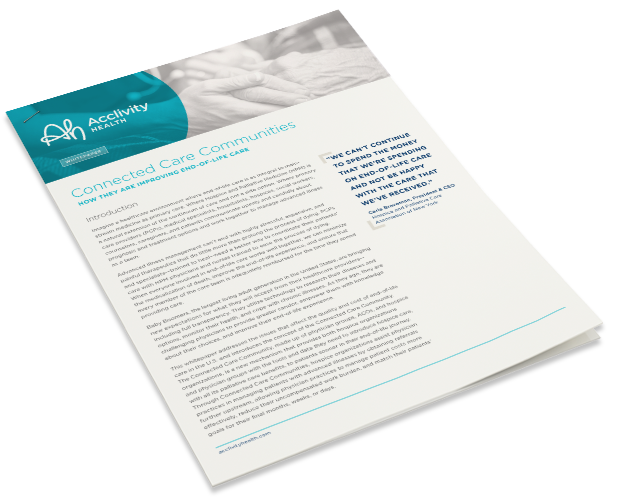Today’s doctors are trained to keep patients alive, but not always to prepare them for death. From developing a care plan to delivering the news to supporting their patients’ medical, emotional and spiritual needs, most doctors are uncomfortable starting the conversations required to develop the most appropriate end-of-life care plans.
As Baby Boomers retire and age, we have an older generation that has grown up expecting continuing gains to their longevity. But longevity doesn’t mean everyone who lives longer lives in good health. In fact, according to the National Centers for Disease Control and Prevention, about 60 percent of adult Americans have a chronic disease, and 40 percent have more than one1. Our medical community needs to ensure that the sickest and most vulnerable in this generation will receive comprehensive, high-quality, person- and family-centered care that honors their dignity and choices and is consistent with their goals and values.
If we continue business as usual, patients will continue to risk ineffective treatments, unnecessary trips to the ER, frequent readmissions to the hospital, and insufficient time to plan for their deaths with their loved ones. And physicians will strain to handle the growing needs of these patients and meet quality metrics set by their Medicare Shared Savings Program (MSSP).
The solution is a new end-of-life care model where providers securely connect and collaborate with multiple disciplines within the care team to provide appropriate and timely services to their shared patient population. This model, which we call the Connected Care Community, gives physicians a support system to introduce palliative care, with all its benefits, to patients sooner in their end-of-life journey. Hospice organizations are considered the best entity to serve as the hub for their Connected Care Communities, based on their unique qualifications to provide a full depth and breadth of end-of-life services. Hospice adds significant value to the community because their professionals and volunteers are trained in the psychosocial aspects of the end-of-life journey and know when and how to start end-of-life care.
With the creation of Connected Care Communities, physicians have an easy way to refer patients to hospice earlier. They can continue to oversee their patients with advanced illnesses, knowing that they have a partner with immediate access to a network of hospice doctors, nurses, social workers, caregivers and volunteers. With less burden, physicians are able to manage the complex needs of patients with terminal illnesses in the most cost-effective way, reduce their time spent on uncompensated work, and improve the quality of their patients’ end-of-life care.
Benefits of a Connected Care Community
- Offer a more holistic way to manage patients’ pain and symptoms.
- Provide greater transparency of care options so patients and families can make informed decisions.
- Limit unnecessary treatments and reduce the cost of care through improved communication.
- Help physicians communicate better with their patients regarding their cultural and personal beliefs related to death and dying.
- Honor patients’ end-of-life wishes so they can experience their vision of a good death.
[1] Chronic Diseases in America. Retrieved February 1, 2019 from https://www.cdc.gov/chronicdisease/resources/infographic/chronic-diseases.htm


